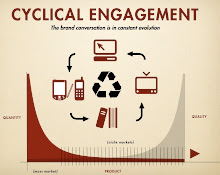Which is what makes content portals like Hulu so very interesting. With Disney's plunge into the mix, Hulu will likely go from the world's 4th largest captive network (including all cable nets), to something that may overtake everybody's favorite behemoth, YouTube. Now, keep in mind, this has very little to with the highly coveted "video content monetization model" (which has yet to take shape), or even content development (although it should), and everything to do with how we, as viewers, consume our media.
First, we have to consider the correlates between online content viewership and long-form content on your TV. Recent studies have shown that those folks who view topical, genre or show-specific content online are likely to seek out and watch this same content in their living room. Starz Online issued a detailed report to TelevisionWeek in January and Neilsen has backed this info up with findings of its own. To boot, folks like Integrated Media Measurement have reported that during most weeks, TV viewers are spending as much as 15% of their viewing time online. And, as Lead Researcher Amanda Welsh stated, "Rather than simply cannibalizing audiences as has been feared, offering content online presents a huge opportunity for television content providers to reach elusive ad-avoiding audiences and to achieve higher engagement with them."
Well, it's no wonder then that Primetime and cable nets like NBC, ABC, VH1, ESPN, GSN, Comedy Central and a host of others are all embracing the once-feared "fragmented" programming model - it actually works. Watch any of your favorite shows these days and you can join polls, forums, blog commentaries or video commentaries, most of it captured in real-time. You'll even see more cross-promotion (network to network) between competitors. Why? Because audiences are about shared interest; increase the market for shared viewership, and you can increase your piece of the pie.
Which brings us to how show content is being promoted online, such as it is on microblogs. Nearly every major network - prime, cable, online or otherwise - has a healthy presence on Twitter, and their updates flow like dynamically-enabled news content or RSS feeds...go figure. I'm a sports fan, so I get my updates from ESPN online, then go to the TV to watch specific clips. It's both interesting and bizarre because two things are evident: a) I now watch TV in intervals, and b) I still don't want to watch these clips on my computer or my iPhone. This may change, but for now, this is my experience, and I know I am not alone.
But there's another twist to this part of the story: search. Remember we mentioned YouTube earlier? Run any datapoint on social media, and you'll find that linking - not originally sourced content - is what gets page rank; in fact, we ran a case study on this in March, and sure enough, we found that most indices are flooded with links and cross-postings. What this tells us is that content may be king, but what people say about that content is even mightier. Hence the YouTube dilemma: microtagging videos ain't gonna do the trick, especially with a Google algorithm that doesn't seem, at this point, to filter or scale very well.
YouTube has another problem in the form of exclusive content and the accessibility of higher quality, mid-tail content. The networks got smart when they realized that a seemingly endless tail of marginal video content would take a hard left and inevitably force content providers to raise the bar on quality. Case and point: people are still paying for premium content, and they're doing this in large part because they're sick of watching recycled content on YouTube, or worse, home video stunts. When you look at average engagement time of video views - even the most popular - this points even further to the fact that good storytelling wins out. Let's see if YouTube can save face with its new content deals - don't count out any of the players in this programming game.
Finally, mobile has arrived (well, it's at least on the cusp of broadband greatness in the U.S.), and will offer up a flurry of hyper-targeted video content. In other words, MicroProgramming. It's taken quite a long time for mobile content to make its mark here - it was projected by some to be a $12B market by 2007 - but we now see a relationship formalizing between text or microblogging and content engagement. This is exciting.
It's funny because 10 years ago or so, we feared that we would be watching content in a small box. Well, that still may be true, but let's not forget that good programming is good programming, and we'll watch it in, on or around the most comfortable spaces we can find at any particular time.
Cheers to MicroProgramming. The new content frontier.







